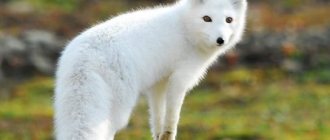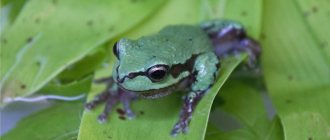The llama is an amazing animal that was domesticated several centuries ago. Today, unusual mammals are just as popular, they are used as beasts of burden, and are also raised on farms to produce high-quality wool and meat. These are hardy and unpretentious workers who can live both on the plains and in the highlands.
Llamas are recognized as the largest mammals in South America, which have survived to this day practically unchanged.
general characteristics
The height of an adult llama can reach 120 cm at the withers and up to 180 cm from the hooves to the head. The weight of mature individuals is from 130 to 200 kg. The body is slightly elongated, the limbs are long and straight. The front and hind legs end in cloven hooves, equipped with soft but dense leathery pads.
The neck is long, rather thin and flexible. The head is small compared to the body. The muzzle is elongated, the ears are long, raised high and slightly tilted forward.
Elena
Ask a Question
Question to the expert
How to distinguish a female from a male?
Sexual dimorphism is weakly expressed, so it is quite difficult to distinguish a female llama from a male. The reproductive organs are hidden by dense fur, but males are slightly larger than females.
At the age of two, males grow back-curved, canine-shaped incisors, which serve the animal for defense and attack. “Combat teeth” are located on the lower (2 pcs.) and upper (4 pcs.) jaws and help males in the fight for females and territory. On farms, fangs are removed, since animals during the rut can cause severe injuries to their rivals.
The fur of domestic animals is much softer than that of their wild counterparts.
A wide variety of colors are found in nature and domestic livestock. The coat can be pure white, black, brown or grey. Very often, llamas are colored in a zone, for example, the lower part of the body is white and the upper part is dark brown. Spotted and even striped colors are also found.
Llamas are very similar to camels. But members of the species do not have a hump and are much smaller than desert caravans. But animals have quite a lot in common. For example, both species have strong, cloven hooves with calloused pads that allow them to move safely over hot sand and rocks. Llamas and camels have canine-shaped incisors on the upper jaw. Animals have a similar digestive system, as well as a unique habit of spitting at offenders and enemies.
Llama saliva is very sticky and is often greenish or yellowish in color. This is due to the fact that saliva contains undigested food particles. Animals are able to spit at a distance of three meters. Before the main spit, llamas raise their muzzle, press their ears to their head, hiss and spit a little to the side.
Llamas have a very long intestine, which in its structure resembles the internal organs of a camel. Thanks to their intestines, animals can go for long periods without water. Llamas are not classified as ruminants. Although they regurgitate semi-digested food for repeated chewing, their stomach consists of only three compartments rather than four. Thanks to the repeated mechanical processing of food, llamas can eat fairly tough vegetation and extract the maximum amount of nutrients from it.
Question to the expert
How long do llamas live?
The average life expectancy is from 15 to 25 years, but there are individuals that live up to 30 years.
Appearance and features
Photo: Animal lama
Llamas look like deer and camels at the same time. However, they have neither horns nor humps. The body is elongated, reaching two meters, rounded and large in cross section, but quite low - the animal’s height at the withers is only a little over one meter, but the llama’s height is slightly compensated by its long, elongated neck. Males are slightly larger than females, which is why people use them for cargo transportation. But the females are kept exclusively for breeding and wool, they are not even milked.
The head is small, elongated, very similar to a camel's. The ears are long, erect, and pointed at the ends. The eyes are black, large, round, located on the sides, framed by thick eyelashes. Llamas lack front teeth; they pinch grass with their lips and grind it with their side teeth.
The llama's neck is disproportionately long and thin compared to the body; it adds a good half of the animal's height. The total height is about two meters, it is at this height that the small head of the animal is located.
Legs are short and thin. The hooves are cloven and there are large calluses on the soles, which is why they, together with camels, are classified into the suborder of calloseds. This is a kind of adaptation to a rocky or hot surface, so that the animal has a reduced chance of injuring its foot. The tail is short, up to 40 cm, looks like a ball of wool.
The entire body of llamas is covered with thick, long fluffy hair. It protects animals from strong winds and cold present in their habitats. Its color varies from white to dark brown and brown shades. The fur on the neck, head and legs is shorter, but the body and tail are covered with very voluminous fur. Llamas also have a hairstyle that looks like a fluffy wig.
Alpaca wool is of particular value; it is the softest and is completely free of sebum. Things made from such wool look very fresh and expensive. On the market, the price for alpaca wool is the highest among llamas.
Habitat
The first llamas lived in North America 40 million years ago. The migration of animals to the South American continent occurred during the opening of the Panama Canal. More than 25 thousand years ago, the llama population in North America was stable, but after a sharp drop in temperatures they completely disappeared from the mainland.
Later, the animals returned to the mainland and successfully adapted to new conditions.
Today, representatives of the species inhabit the western part of South America, widely distributed throughout the Andes Mountains, Chile, Argentina, Bolivia and Peru. And also in some parts of North America.
What do llamas eat?
Llamas, like all animals from the camelid family, are very unpretentious and can eat almost any plant food. In their natural habitat, llamas eat fresh greens. The diet of herbivores consists of grass, young shoots of bushes and trees, as well as foliage and moss. During periods of starvation, llamas eat dry grass, branches of low-growing bushes and lichens.
Thanks to their long necks, animals can calmly eat everything that is under their feet, so in case of danger they take off with lightning speed.
Plant food fully meets the needs of animals for microelements and other nutrients. But constant activity requires a lot of energy, so llamas spend most of the day searching for food.
During dry periods, llamas calmly tolerate the lack of water. They can get all the necessary moisture from succulent plants. Eating greens protects the animal’s body from dehydration and will allow them to wait out unfavorable times without harm to the body.
When feeding, the llama cuts grass and tender shoots with its front incisors, and then chews them thoroughly on its molars. Thanks to the structure of their jaws, llamas can eat not only soft grass, but also fairly strong stems and branches.
Unlike many other herbivores, llamas do not spoil pastures. The structure of the jaws allows animals to cut the grass rather than uproot it. Llamas' hooves are softer and do not damage the fertile layer and roots of plants, so pastures are restored very quickly.
Nutrition
This unique animal is a herbivore. His favorite food is grass and ferns in the wild. To feed the llama on the form, you will need to make hay. The animal eats a little. The daily requirement of an adult llama is about 3 kg of hay.
This is a very picky living creature in everything, including food. If there is not enough grass, the llama will happily eat fruits, vegetables and even moss or lichen.
At home, livestock breeders observe that llamas prefer cabbage, carrots, and bread. Pregnant females need a balanced diet. Food should be filling and high in calories.
Reproduction and raising of offspring
Sexual maturity in llamas depends on gender, females are ready to breed as early as 12 months after birth, and males can only mate in the third year of life.
Mating season
Recommended by topic
Fox Panda Lynx
The rutting period begins with the arrival of spring, but female llamas do not go into heat, so they can breed at any time of the year. This feature arose due to external stimulation of the animal’s body. During mating, the ovulation process starts, the newly formed egg is fertilized on the first try.
Surprisingly, the mating process is not entirely normal. The female lies down on the ground, after which the male covers her. The whole process lasts about 20–40 minutes, which is also not entirely typical for such large ungulates.
Guanacos in the wild begin to mate around August. But the rut ends only at the beginning of February.
The breeding season in all species is accompanied by a struggle for females and feeding areas. Adult males protect their harem, and young males try to enter the protected territory. Males rise on their hind legs and strike their opponent with their front legs. Llamas head butt the enemy, bite and spit.
Despite their cute appearance, members of the family are very aggressive and ruthless opponents. After fights, multiple wounds can be found on the skin of males, and in some individuals ears, tips of tails and even testes have been bitten off.
Duration of pregnancy and childbirth
On average, pregnancy lasts about 11 and a half months. Usually one cub is born and very rarely two babies.
Among lamas there is a very developed sense of empathy. Representatives of the species surround the giving birth female with a dense ring, rub their muzzles, hum softly and encourage them in every possible way. At this time, the male vigilantly monitors the surrounding world and looks out for danger.
Llamas begin to give birth standing up, but when the fetus moves through the birth canal, they lie down. This stimulation helps the baby to be born. The weight of newborn crias is from 9 to 15 kg. The baby comes into the world with wide open eyes and completely covered with fur. After just a few hours, the cub can stand on its legs and follow its mother.
Caring for the Cubs
Females are very caring mothers and do not leave their cubs for a minute. Surprisingly, if there are several babies in the herd, then the females can look after both their own and strangers, and sometimes even feed them.
A llama's tongue can only protrude 13mm, so mothers don't lick their babies. In return, the females rub their noses against the cubs, sniff them, and make melodious hooting sounds.
The lactation period lasts about four months, but in some cases the milk may disappear only after 8 months. Llama milk is not fatty, but it contains large amounts of calcium and phosphorus.
The llama's mammary gland is small and can only store 60–70 ml of milk at a time. Therefore, the cubs eat little by little, but very often.
Grown-up kids do not leave the herd, but remain in the group. Females can live next to their mother all their lives, but males are forced to leave the herd at the age of three.
Features of character and lifestyle
Photo: Lama
Llamas are very calm; during the day they are active and graze, roaming in search of more succulent grasses. At night they rest near rocks, trees or in stalls. Thanks to their low maintenance and docile nature, llamas were quickly and easily tamed and used in agriculture. Despite their quiet temperament, llamas can run quite fast, sometimes reaching speeds of 50 km/h.
In the wild, herds are small. They usually consist of one male and up to ten females. There is a strict hierarchy in the herd. Outside males are strictly not accepted. To communicate with their relatives, llamas use body language, which consists of tilting the ears, turning the neck and various positions of the body. In case of danger, they make low roaring sounds, similar to those of donkeys.
Llamas have very good eyesight, as well as a sense of smell and hearing. All three qualities together help them flee at the slightest danger. They can sense the presence or approach of potential enemies even at a great distance. Shepherds learned to use this ability by enlisting llamas to guard herds of smaller animals such as sheep or goats.
The nature of llamas suits attempts to train these animals. There are shows where llamas follow certain human commands and learn to perform certain tricks. The lifespan of llamas in the wild is approximately 20 years, in captivity it is even longer, up to 30 years.
Interesting fact: one of the characteristics of these animals is their cleanliness. Llama excrement is always collected in one place, away from fields, grazing areas, feeders and from trails and grazing areas. This is explained by the fact that in the wild, llamas have learned to disguise their location in this way in order to hide from dangerous predators.
Interesting Facts
Llamas and their close relatives are amazing animals. Despite the fact that the first llamas were domesticated many centuries ago, they never cease to amaze ordinary people with their appearance and habits.
Interesting Facts:
Recommended by topic
Tiger Meerkat Horse
- At the age of three, male llamas grow 3 pairs of canine-shaped incisors. They are curved back and very sharp.
- During a fight, male llamas actively bite and headbutt their opponent.
- During the rut, sexually mature males try to bite off the testicles of all rivals in order to eliminate competitors. Because of this feature, farmers have to remove the fangs of adult males.
- Llamas are very smart and are often used as shepherds and guards for sheep. Not every predator or stranger will dare to walk past an adult male llama standing on duty.
- Thanks to their flexible intelligence, llamas perfectly remember commands and are trainable.
- A llama and a camel can have common offspring. But artificially bred hybrids (Kama) cannot reproduce.
- A hybrid of a llama and an alpaca is called a huarizo.
- Vicuna fur is considered the most valuable among the representatives of the family. Items made from vicuña wool are recognized as the most expensive.
- In order to trim wild vicuñas, they are rounded up into herds and driven into a temporary pen. After shearing, the animals are released into the wild. This haircut is possible only once every three years.
- The coat of arms of Peru features a vicuña.
- Alpacas do not have front incisors, so they do not cut grass, but carefully pinch it off with their lips.
- Vicunas are the only members of the family whose front incisors grow throughout their lives.
- Only males are used to carry heavy loads. Female llamas are less hardy and are designed to give birth to offspring.
- For centuries, the llama has been the most popular, and in some places the only, beast of burden in remote areas of the Alps.
- The alpaca is a social animal and cannot live outside the herd. Purchased individuals can become sad and even die from loneliness, so experts advise getting a pair of alpacas at once.
- Surprisingly, male llamas will never carry a load that exceeds 50 kg. They simply refuse to move forward and lie down or sit on the ground. If the driver insists on his own, the lama will simply spit in his face.
- An alpaca, unlike a llama, does not bite or butt its head. Representatives of the species have a softer and more flexible character.
- The indigenous people of the Andes call llamas “silent brothers” and consider them sacred animals.
- Scientists have noticed that communication with alpacas and llamas gives a lasting calming effect, so they are used as therapy animals in nursing homes, schools for underdeveloped children and in hospitals.
- In mountainous areas there is very little solid fuel, so locals use dried llama droppings to make a fire.
- Llamas are very brave and fearless animals. A small herd can ward off coyotes, dogs and even cougars.
FAQ
Why do llamas spit at people?
In their natural environment, llamas, like camels, use spitting to demonstrate their status and superiority over their opponents. Animals can spit at a rival, an unwanted suitor during the breeding season, or at a predator. Dominant llamas may spit at subordinates if they do not move away from the feeder or block the way. That is, a lama can spit at a person if he suspects his behavior is aggression, a threat to himself or his offspring. Animals can also spit in the face of an overly annoying or noisy person.
Why is a llama called a llama?
Answer: The name of the animal “Auchenis lama”, according to some versions, is considered to be a borrowed word from the German word Lama or French Lama, perhaps the word is taken from the Spanish llama, which comes from the word llama in the Quechua language (Peru).











